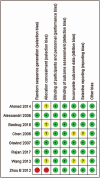The timing of urinary catheter removal after gynecologic surgery: A meta-analysis of randomized controlled trials
- PMID: 31914080
- PMCID: PMC6959902
- DOI: 10.1097/MD.0000000000018710
The timing of urinary catheter removal after gynecologic surgery: A meta-analysis of randomized controlled trials
Abstract
The present study aimed to assess the effect of removing an indwelling urinary catheter at different times on urinary retention and urinary infection in patients undergoing gynecologic surgery.Electronic databases including PubMed, EMbase, the Cochrane Central Register of Controlled Trials, and Ovid from inception to June 2018 were searched. Relevant randomized controlled trials (RCTs) of removal the indwelling urinary catheter in different time were included.Eight RCTs were included. Data were analyzed by RevMan 5.3 version. There was significant difference in urinary retention (relative risk [RR] 2.46, 95% confidence intervals [CIs] 1.10-5.53), P = .03) between the ≤6 hours and >6 hours indwelling urinary catheter removal groups, while no significant differences were found in the gynecologic surgery excluded the vaginal surgery group and vaginal surgery group. When compared with >6 hours indwelling urinary catheter removal group, the incidence of urinary infection was significantly reduced at the ≤6 hours removal group (RR = 0.66, 95% CI 0.48-0.89, P = .007). The urinary catheter removal time at ≤6 hours also significantly reduced the incidence of urinary retention (RR = 5.06, 95%CI 1.74-14.69, P = .003), and did not statistically increase the incidence of urinary infection (RR = 0.30, 95%CI 0.08 to 1.20, P = .09), compared with immediate urinary catheter removal after surgery.Removal time of the urinary catheter at ≤6 hours postoperatively seems to be more beneficial than immediate or >6 hours for patients undergoing gynecologic surgery which excluded the vaginal surgery.
Conflict of interest statement
The authors have no conflicts of interest to disclose.
Figures







Similar articles
-
Feasibility of immediate removal of urinary catheter after laparoscopic gynecological surgery for benign diseases: A meta-analysis of randomized controlled trials.Int J Gynaecol Obstet. 2022 Dec;159(3):622-629. doi: 10.1002/ijgo.14283. Epub 2022 Jun 3. Int J Gynaecol Obstet. 2022. PMID: 35616374 Review.
-
Strategies for the removal of short-term indwelling urethral catheters in adults.Cochrane Database Syst Rev. 2021 Jun 29;6(6):CD004011. doi: 10.1002/14651858.CD004011.pub4. Cochrane Database Syst Rev. 2021. PMID: 34184246 Free PMC article.
-
Early versus delayed removal of indwelling urinary catheter after elective cesarean delivery: systematic review and meta-analysis of randomized controlled trials.J Matern Fetal Neonatal Med. 2020 Aug;33(16):2818-2825. doi: 10.1080/14767058.2018.1557142. Epub 2019 Jan 7. J Matern Fetal Neonatal Med. 2020. PMID: 30522371
-
Effect of early removal of urinary catheter on recovery after vaginal surgery: A systematic review and meta-analysis.Taiwan J Obstet Gynecol. 2024 Jul;63(4):451-458. doi: 10.1016/j.tjog.2024.05.005. Taiwan J Obstet Gynecol. 2024. PMID: 39004470
-
Urinary Catheter Management Approaches Among Women Undergoing Benign Gynecologic Surgery: A Randomized Trial.Female Pelvic Med Reconstr Surg. 2020 Dec 1;26(12):e73-e77. doi: 10.1097/SPV.0000000000000781. Female Pelvic Med Reconstr Surg. 2020. PMID: 31688528 Clinical Trial.
Cited by
-
Working towards an ERAS Protocol for Pancreatic Transplantation: A Narrative Review.J Clin Med. 2021 Apr 1;10(7):1418. doi: 10.3390/jcm10071418. J Clin Med. 2021. PMID: 33915899 Free PMC article. Review.
-
A systematic review comparing early with late removal of indwelling urinary catheters after pelvic organ prolapse surgery.Int Urogynecol J. 2021 Jun;32(6):1361-1372. doi: 10.1007/s00192-020-04522-y. Epub 2020 Sep 4. Int Urogynecol J. 2021. PMID: 32886172
-
Rethinking dogma: Can urinary catheters be filled with air? A feasibility study.Curr Urol. 2022 Mar;16(1):53-54. doi: 10.1097/CU9.0000000000000085. Epub 2022 Mar 31. Curr Urol. 2022. PMID: 35633862 Free PMC article. No abstract available.
-
Effect of Lactobacillus plantarum Biofilms on the Adhesion of Escherichia coli to Urinary Tract Devices.Antibiotics (Basel). 2021 Aug 11;10(8):966. doi: 10.3390/antibiotics10080966. Antibiotics (Basel). 2021. PMID: 34439016 Free PMC article.
-
Investigating Polypyrrole/Silver-Based Composite for Biofilm Prevention on Silicone Surfaces for Urinary Catheter Applications.ACS Omega. 2025 Feb 17;10(7):7058-7068. doi: 10.1021/acsomega.4c10109. eCollection 2025 Feb 25. ACS Omega. 2025. PMID: 40028113 Free PMC article.
References
-
- Ouladsahebmadarek E, Sayyah-MelIi M, Jafari-Shobeiri M. A randomized clinical trial to compare immediate versus delayed removal of foley catheter following abdominal hysterectomy and laparotomy. Pak J Med Sci Q 2012;28:380.
-
- Cormio L, Mancini V, Liuzzi G, et al. Cystocele repair by autologous rectus fascia graft: the pubovaginal cystocele sling. J Urol 2015;194:721–7. - PubMed
Publication types
MeSH terms
LinkOut - more resources
Full Text Sources
Medical

